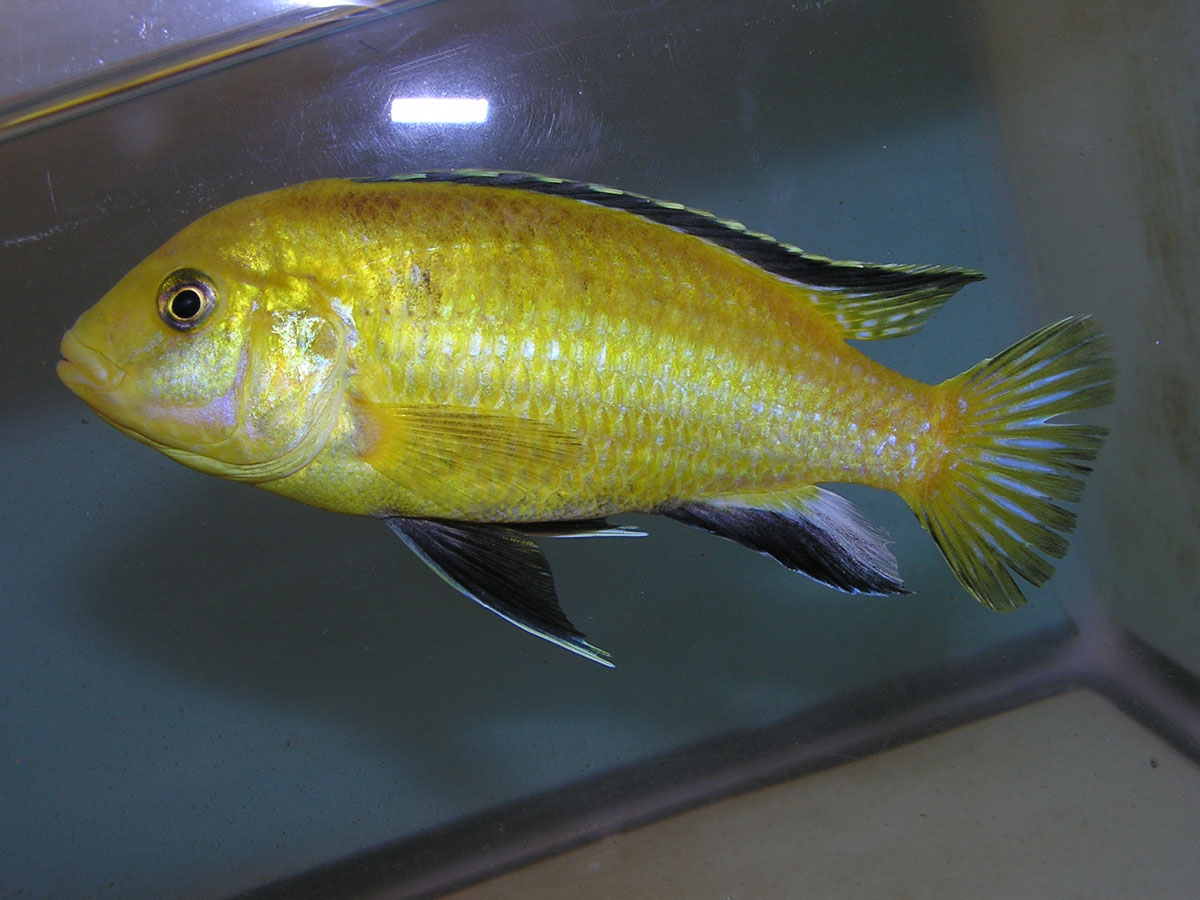Photo: A male Labidochromis caeruleus ‘Gold’ or ‘Lemon Yellow Lab.’
We raise a lot of African cichlids, especially those from Lake Malawi in East Africa. One of these is very popular with our aquarium maintenance customers due to its bright yellow coloration. This species is Labidochromis caeruleus ‘Gold.’ The ‘Gold’ designation indicates it is the yellow morph of this species, which also comes in a blue morph. In fact, the Latin “caeruleus” means blue. Nevertheless, it’s the yellow color morph that is commonly found in the US; I’ve never seen the blue morph except in photos. The yellow morph is also commonly known as the “lemon yellow lab.”
We’ve had this fish a long time, but my records fail me and I can’t find the source or date of acquisition. I suspect it was in 2003 after Hurricane Claudette during which we lost lots of breeder fish. After rebuilding our damaged greenhouse we rebuilt our stocks and transitioned away from rainbowfishes by acquiring many cichlids and livebearers from two Florida fish farms. It wasn’t the first time I owned this species; I’d had it decades ago when it first arrived in the US. The ones I had at that time had females with no black in their fins. Our current females unfortunately have black in their fins, slowing down sorting of the sexes when we process them.
This week we processed these cichlids. “Processing” consists of netting the fish out of their vats and placing them in five gallon buckets with airlines dropped in to keep them while their vats are cleaned and set up again. Typically, we have six vats for each variety of cichlids. One 300 gallon vat houses the breeding colony. Five 55 gallon vats house sale fish as follows:
- 1-2” fish
- 2-3” fish
- 3-4” fish
- Adult females
- Adult males
We sometimes also have a vat labelled “BRU” which stands for “breeders unsexed” but really means fish we might want to add to the breeding colony the next processing cycle.
Once their vats are ready, we sort the fish into the groups above. By size sorting the fish we make it easier to fill orders. And by separating the adult sexes we prevent females from carrying eggs which reduces their condition. We aim to have large numbers of fish in each vat for two reasons. First, aggression is much reduced in crowded tanks since no one fish can dominate and no one fish gets picked on all the time. Fish can’t set up and defend territories, which also reduces conflict and aggression. Secondly, fish eat more and more eagerly when crowded. More food eaten leads to better health and faster growth. Our cichlids typically grow and inch a month.
This cycle we set up a breeding colony of four males and 30 females. I usually prefer having only two males but up to 50 females. Why did I do this? It’s a bit complicated. So let me digress.
When we first got this fish I selected very yellow breeder males and yellow females, preferring females with little to no black in their fins. Like I said earlier, it’s easier to sex sort the fish if the males and females look different. I’ve had little success in breeding out the black from the females and have pretty much given up on this goal. A problem we had with this selection method for breeders is that we ended up with a high percentage of females that were olive-yellow or very pale yellow (almost silver) rather than a nice clear yellow. We purged these as they appeared and placed them into “mixed Mbunas” sales tanks. But they continued to appear each generation in disturbingly high numbers. And Susie, my wife and business partner, didn’t like that. Since “mixed Mbunas” don’t bring as much money per fish she suggested (that’s a euphemism for “demanded”) I do something about this problem.
The male pictured at the top is not a current breeder. I’ll try to get around to photographing the orange males next time we process this fish, probably in about four months. Below is a photo of a young female that showed promise of having yellow rather than black fins. She disappointed me and developed black fins as she matured. Another annoying characteristic of our females is their growth of pointed fins as they grow up. That makes sex sorting slow.

So, I did some experimenting. I set up small breeding colonies of one male and six to eight females in 55 gallon vats. After a year plus of testing I found that males displaying an almost orange color coupled with canary yellow females produced the fewest culls. Really yellow males coupled with nice yellow females produced a high proportion of off color fish, especially females. I had the results I needed to improve the strain.
So, why the smaller number of female breeders and more males than usual? Because two breeding cycle ago, I selected breeders based on the results of my testing. We had two very fine breeder males showing orange coloration and only 40 females that had nice clear canary yellow coloration. The results of this breeding cycle were striking; the numbers of off color fish declined sharply. So, the next cycle I kept the same breeders with the same result. By this current cycle we’d lost 10 of the breeder females, which is fairly typical since breeders are mature and almost two years had passed. Being a female cichlid which carries eggs and fry from a significant portion of her life can often be over-stressed. We never strip eggs. All of our mouthbrooders carry to term.
So I kept remaining females since they were producing fish I wanted. This cycle I also added two young males that showed lots of promise. Next cycle I’ll add young females to bring the breeding colony up to 40 to 50 fish. I’ll continue to select bright canary yellow females and orange males.
It’s gratifying to see the results of selection to improve a strain. It’s not gratifying to have failed in producing females without black fins. I continue to watch for a female with yellow only fins. I guess I could try to purchase such a female, but I like our strain and its productivity. But, if I stumble across such a female I’ll set up a test mating with one of our best males to see what happens.
Good fishkeeping!


Kayla says
I am looking to sell several females with no black in their fins please contact me at 931 262 0347 if you’re interested. Thank you. My name is Kayla Hadley
Charles Clapsaddle says
Kayla,
Our females have black fins unfortunately. It would be nice to have females with yellow fins; it would make sexing easier.
Charles
Charles Clapsaddle says
Kayla,
I misread your message. I am interested, but not until we complete Hurricane Harvey recovery.
charles